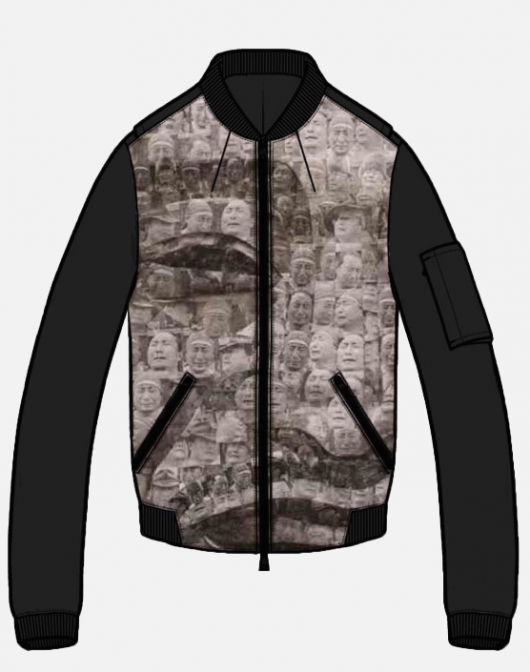ITALIAN YARN
Bozzetto del bomber di Costume National per Fashion for Tibet
Per parlare di moda etica, a volte, si rende necessario cercare il bandolo della matassa. Perché è il filo il «padre» di ogni tessuto e, da come viene ottenuto e poi tinto e lavorato, si può distinguere se ci troviamo davanti ad un capo completamente safe o se, invece, a dei lati oscuri. Da qualche anno Greenpeace ha lanciato la campagna Detox che premia le strategie aziendali volte a fare risparmiare acqua, energia e emissioni di Co2. Nel mondo hanno aderito velocemente colossi come H&M e Zara. Per l’Italia si è distinta la Miroglio Textile: la holding italiana ha eliminato dai suoi filati ogni possibile traccia di inquinamento e di questa lotta ha fatto una bandiera. Rappresenta un salto rispetto alle altre aziende perché ha deciso di risalire all’origine di tutto il processo lavorativo di un capo di abbigliamento partendo, appunto, dal filo, invece che dal tessuto. Che poi fabbrica con un processo “verde” per i lavoranti e l’ambiente. E se Miroglio si distingue per il suo programma di eco sostenibilità, bisogna anche sottolineare che l’uso dei filati italiani è in ogni modo una base per ottenere una completa tracciabilità dei nostri capi di abbigliamento sia naturali sia sintetici. Come fa Costume National, ad esempio, che ha di recente unito elementi di «moda buona» ad altri di «moda etica». Ennio Capasa, il suo fondatore, ha aderito alla prima edizione di Fashion for Tibet, manifestazione volta al sostegno della popolazione e della cultura tibetana. Capi di moda sono stati creati da designer di fama internazionale e da marchi che hanno preso la loro ispirazione dalla mostra ‘Trascending Tibet”, opere d’arte di ventisei artisti tibetani contemporanei e quattro occidentali e asiatici il cui lavoro incorpora temi tibetani. La mostra culminerà in un cocktail e un’asta dal vivo degli oggetti offerti la sera del 9 Aprile al Rogue Spazio Chelsea. Capasa partecipa con un bomber maschile di tessuto tecnico da lui ideato, del tutto Made in Italy e quindi completamente tracciabile anche se sintetico. Buono e salubre. Luisa Ciuni
Talking about ethical fashion requires, sometimes, to look for the end of the skein. Because the yarn is the origin of every fabric, and we can understand if a garment is safe or not on the basis of how it is obtained and then dyed and worked. Since a few years ago Greenpeace has started the Detox campaign, that rewards the company strategies intended to save water, energy and Co2 emissions. Giants like H&m and Zara joined quickly. In Italy the Miroglio Textile did it: the italian holding removed from its yarns any possible trace of pollution. It represents a leap compared with the other companies, because it decided to go back to to the origin of the production process of a garment starting, indeed, from the yarn and not from the fabric. Made with a “green” process, for both workers and environment. And if Miroglio distinguishes itself for its ecosustainable plan, we have to say that using italian yarns could be a starting point to obtain a complete traceability of our clothes. Like Costume National, for example, that has recently joined elements of “good fashion” with elements of “ethical fashion”. Ennio Capasa, its founder, has taken part to the first edition of Fashion for Tibet, an event designed to support Tibetan people and culture. Fashion garments have been created by very popular designers and brands that have taken inspiration from the exhibition “Trascending Tibet”, artworks of twentysix contemporary Tibetan artists and four occidental/asian whose works incorporate tibetan subjects. The exhibition will culminate with a cocktail and a live auction on April 9th at Rogue Spazio Chelsea. Capasa participates with a bomber jacket made of technical fabric, which is totally Made in Italy so completely traceable, even if it’s synthetic. Good and healthy. Luisa Ciuni
NESSUN COMMENTO






